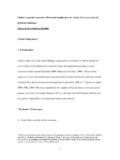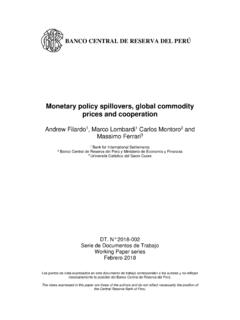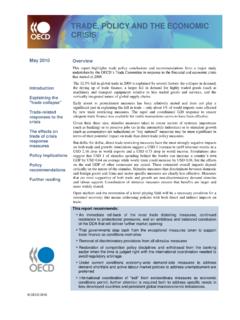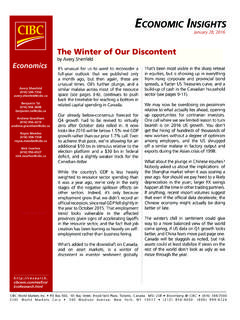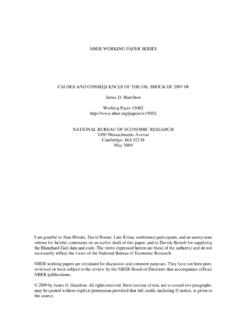Transcription of Nigeria’s Economic Growth and Recovery Plan
1 Nigeria s Economic Growth and Recovery plan Summaries of the 140-Page Document with Suggestions to the Capital Market Economic Research and Policy Management Division, Office of the Chief Economist (OCE), Securities and Exchange Commission, Abuja, Nigeria. March, 2017 OCE Policy Brief Nigeria s Economic Growth and Recovery plan 1 | P a g e Table of Contents 1. Introduction .. 2 2. Restoring Growth Macroeconomic Stability .. 3 Objectives of the plan .. 3 Achieving the Objectives .. 3 Reference to the Capital Market in the plan .. 3 Suggestions to the Capital Market.
2 3 3. Restoring Growth Economic Diversification .. 4 Objectives of the plan .. 4 Achieving the Objectives .. 4 Reference to the Capital Market in the plan .. 4 Suggestions to the Capital Market .. 4 4. Building a Competitive Economy .. 5 Objectives of the plan .. 5 Achieving the Objectives .. 5 Reference to the Capital Market in the plan .. 5 Suggestions to the Capital Market .. 5 5. Investing in Our People .. 6 Objectives of the plan .. 6 Achieving the Objectives .. 6 Reference to the Capital Market in the plan .. 6 Suggestions to the Capital Market .. 6 6. Governance.
3 7 Objectives of the plan .. 7 Achieving the Objectives .. 7 Reference to the Capital Market in the plan .. 7 Suggestions to the Capital Market .. 7 7. Delivery .. 8 Focus on priorities .. 8 Establish clear accountability .. 8 Set targets and developed detailed action 8 Mobilize and allocate resources to priorities.. 8 Create an enabling policy and regulatory environment.. 8 Monitor and drive progress .. 8 Communication .. 8 8. Conclusion .. 9 2 | P a g e 1. Introduction Government is keen to improve the resilience of the economy and make it less vulnerable to external shocks through a reduction in its dependence on the oil sector, and better implementation of government policies.
4 The economy s overdependence on crude oil has amplified the gravity of the recession that had its origin mainly from adverse developments in international crude oil market. In response to the need to lay a solid foundation for the economy to emerge out of recession and restore Economic Growth , the government of President Muhammadu Buhari on 7th March 2017 released the Economic Recovery and Growth plan (ERGP), a medium term plan (2017-2020) which builds on Strategic Implementation plan (SIP) earlier developed for the 2016 budget.
5 The ERGP aims to achieve sustained inclusive Growth , driven by the following principles: focus on tackling constraints to Growth ; leveraging the power of the private sector; promoting national cohesion and social inclusion; allowing markets to function and; upholding core values in Nigeria s Constitution. The three broad strategic objectives of ERGP are to: i) restore Growth through macroeconomic stability and Economic diversification; ii) build a globally competitive economy through investment in infrastructure, improvement in business environment and promotion of digital-led Growth and; iii) invest in the Nigerian people through programmes on social inclusion, job creation, youth empowerment and improved human capital.
6 Earlier Plans have delivered limited results. The authorities hope to improve the performance of the current plan by introducing a set of six important features: i) A strong political commitment with a focus on implementation is reflected in the establishment of a Delivery Unit in the Presidency and Monitoring and Evaluation exercise to be conducted by the Ministry of Budget and National Planning (MBNP); ii) Pursuit of some bold initiatives such as raising oil production to by 2020, privatisation of selected public assets, revamping the refineries and environmental restoration in the Niger Delta; iii) Incorporation of previous plans like the National Industrial Revolution plan (NIRP) and Nigeria Integrated Infrastructure Master plan ; iv) Proposed support for the private sector to become the engine of national Growth and development and the application of science and technology.
7 V) The merger of Budget and Planning into the MBNP will ensure budgets are properly aligned with planning for effective implementation; vi) Collaboration with State Governments for common goals and coordination. Since its announcement, the 140-page plan has generated mixed reactions. Many commentators and reviewers have understandably been interested in what the plan implies for their areas of interest. This brief aims to provide a summary of important aspects of the plan and draw its implications to the economy in general and the capital market in particular.
8 Therefore, the broad purpose of this Policy Brief is to summarise the document into a few pages and draw relevant implication and suggestions for the capital market. Specifically, for each of the sections of the plan , this Brief presents: i. A background of the situation ii. Objectives of the plan iii. Strategies of the plan to achieve objective iv. Reference to the capital market in the plan v. Suggestions to the capital market The last section of this Brief presents a summary of the different sections along with recommendations that may be useful to operators in the capital market, and government in the course of plan implementation.
9 Nigeria s Economic Growth and Recovery plan 3 | P a g e 2. Restoring Growth Macroeconomic Stability In Nigeria, the oil and gas sector accounts for approximately 94% of export earnings and about 62% of government revenue. The decline in global oil prices and the instability in the oil producing areas of the country have contributed to significant reduction in import earnings. Concomitantly, foreign exchange reserves fell by from US$ billion in December 2015 to US$ billion in December 2016. The ensuing Economic recession that started in 2016 have seen both unemployment and inflation rates rise.
10 Inflation in particular rose from in 2015 to by the first quarter of 2017. Objectives of the plan The objectives of the plan are to restore macroeconomic stability, promote sustained Economic Growth , stabilize monetary, fiscal and external policies and create jobs. The plan targets an annual average Growth of over the period, and to bring inflation to single digit ( )by 2020. Other selected macroeconomic indicators are projected as shown in table 1 Table 1: Macroeconomic Projections 2016 2017 2018 2019 2020 Real GDP Growth % Inflation rate % Oil production (mbpd) Oil Price Benchmark ($) Unemployment plus underemployment (%) Government revenue (% of GDP) Oil Non-oil Budget Deficit (% of GDP) Domestic (% of financing) Foreign (% of financing)





